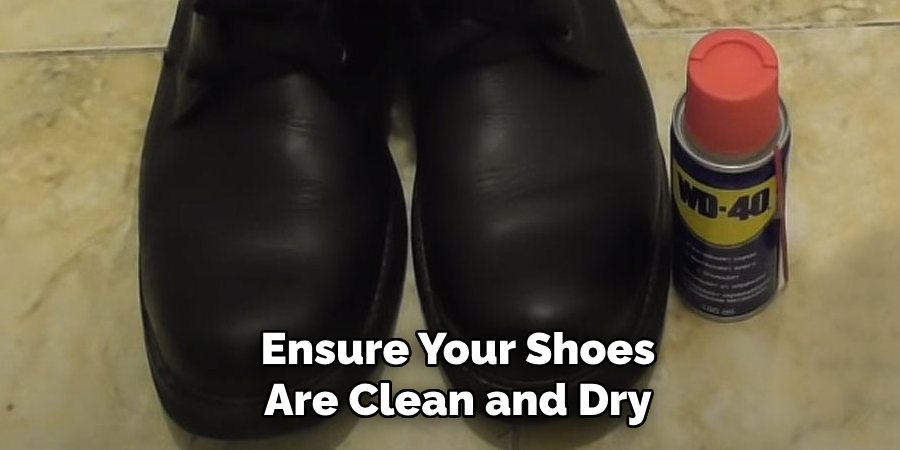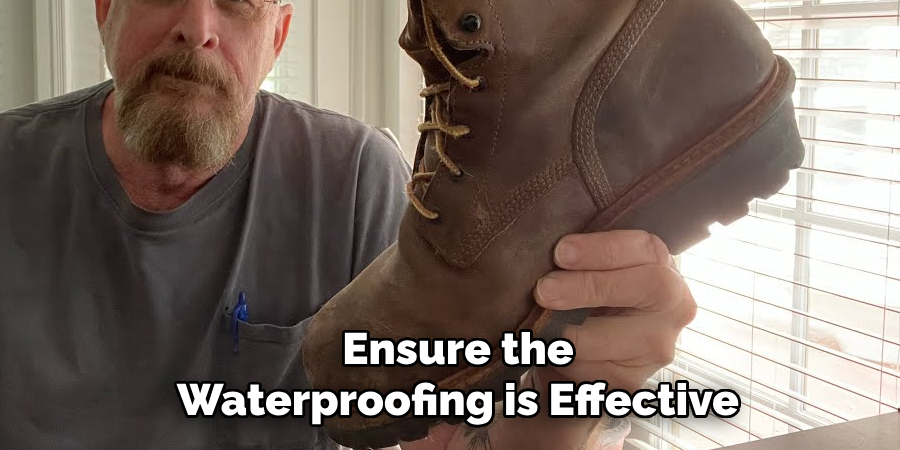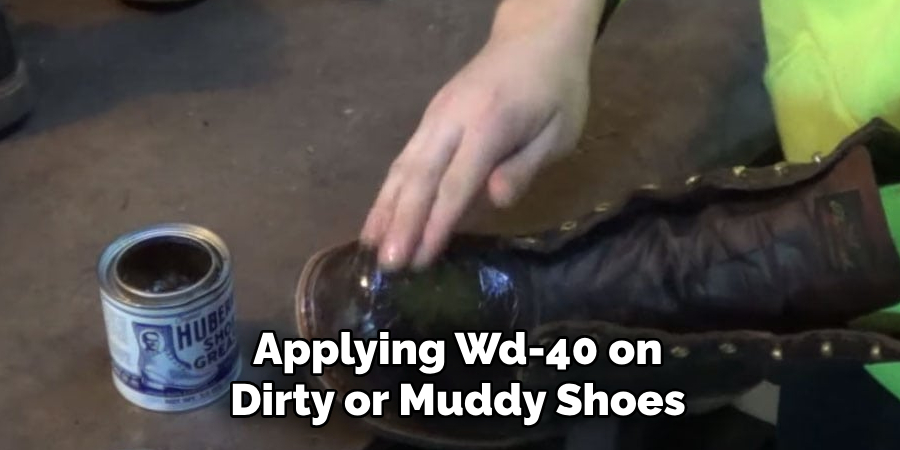Are you tired of your shoes getting wet and soggy every time it rains or you step in a puddle? Don’t worry, we’ve got you covered! In this guide, we will show you how to waterproof shoes with wd40.

Waterproofing your shoes is essential to protect them from water damage and extend their lifespan. Whether preparing for a rainy day, trudging through wet terrain, or simply looking to keep your footwear in top condition, using WD-40 is an effective and affordable method. This versatile household product creates a water-resistant barrier on your shoes, helping to repel moisture and keep your feet dry.
Best of all, the process is quick and simple, making it easy to maintain your favorite pairs of shoes.
What Are the Benefits of Waterproofing Your Shoes?
Before diving into the steps of waterproofing shoes with WD-40, let’s first understand why it’s important. Apart from keeping your feet dry and comfortable, here are some other benefits of waterproofing your shoes:
- Protection from Water Damage: When shoes get wet, they can become warped, cracked or discolored. Waterproofing prevents this from happening and helps maintain your shoes’ overall appearance and structure.
- Increased Durability: By creating a barrier against moisture, waterproofing can help prolong the lifespan of your shoes by preventing premature wear and tear.
- Versatility: While most commonly used on leather footwear, WD-40 can also be used to waterproof various materials, including canvas and suede.
- Cost-effective: Instead of investing in expensive waterproof shoes or sprays, WD-40 is a budget-friendly option to protect your shoes from water damage.
Now that we’ve covered the benefits, let’s move on to the steps for waterproofing your shoes with WD-40.
What Will You Need?
- A can of WD-40
- Your shoes (clean and dry)
- A cloth or brush for application
Once you have these items ready, you can start waterproofing your shoes!
8 Easy Steps on How to Waterproof Shoes With Wd40
Step 1: Clean Your Shoes
Before applying WD-40, you must ensure your shoes are clean and dry. This step helps remove dirt, dust, and debris, allowing the waterproofing layer to adhere properly to the material. Start by brushing off any loose dirt with a soft-bristled brush or wiping the surface gently with a damp cloth.

If your shoes have stubborn stains, use a mild soap or specialized shoe cleaner with water to address them. Make sure to rinse off any soap residue thoroughly, as it may interfere with the waterproofing process. Once your shoes are clean, let them air dry thoroughly before moving to the next step. Applying WD-40 to wet shoes can reduce its effectiveness and leave an uneven coating.
Step 2: Shake the WD-40 Can
Before spraying WD-40 on your shoes, shake the can thoroughly. This ensures that the formula is well-mixed and ready for even application. Shaking the can helps distribute the active ingredients evenly, which is crucial for achieving optimal waterproofing results. Aim for about 15-20 seconds of shaking before proceeding to the next step.
Step 3: Spray an Even Coat of WD-40
Hold the WD-40 can approximately 6-8 inches away from your shoes and spray a consistent, even coat over the surface. Make sure to cover all areas, including seams and stitching, as these are common points where water can seep through. Avoid oversaturating any area to prevent buildup, which may take longer to dry. For best results, work in a well-ventilated area and take your time to ensure complete and thorough coverage.
Step 4: Allow the Shoes to Dry
After applying WD-40, allow your shoes to dry completely before using them. Place them in a well-ventilated area and give the product time to bond with the shoe material. This can take approximately 24 hours, depending on the environment’s temperature and humidity. Avoid wearing the shoes until they are fully dry to ensure the waterproofing effect is effective and long-lasting.
Step 5: Test the Waterproofing

Once the shoes are completely dry, perform a simple test to ensure the waterproofing is effective. Sprinkle a small amount of water onto the surface of the boots and observe if the water beads up and rolls off. If the water penetrates the material, you may need to reapply WD-40 and repeat the drying process. If the waterproofing succeeds, your shoes are ready for use in wet conditions.
Step 6: Maintain the Waterproofing
To keep your shoes effectively waterproofed, reapply WD-40 as needed. Regular use or exposure to harsh conditions may diminish the waterproofing over time. Inspect your boots periodically and repeat the application process if you notice areas where water no longer beads up. Proper maintenance ensures your shoes remain durable and ready for use in wet or challenging environments.
Step 7: Clean and Store Properly
After using your waterproofed shoes in wet or muddy conditions, clean them carefully to maintain their effectiveness. Use a soft brush or cloth to remove dirt and debris, avoiding harsh chemicals that could compromise the waterproofing. Once cleaned, allow the shoes to dry completely in a well-ventilated area, away from direct heat sources. Proper cleaning and storage will prolong the life of your boots and preserve their waterproofing properties.

Step 8: Test Before Extended Use
Before relying on your waterproofed shoes for extended use in harsh or prolonged wet conditions, test them by exposing them briefly to water. This can be done by splashing water on the surface or stepping into a shallow puddle. Check for any leaks or areas where water penetrates the material. Address any issues by reapplying waterproofing as needed. Testing ensures your shoes are fully prepared to handle demanding environments without unexpected failures.
By following these steps, you can effectively waterproof your shoes with WD-40, providing protection and durability for a wide range of footwear.
5 Things You Should Avoid
- Using WD-40 on Fabric Shoes: Avoid using WD-40 on delicate fabric or mesh shoes as it may lead to discoloration or damage to the material. WD-40 is better suited for leather or synthetic surfaces.
- Overapplying the Product: Applying too much WD-40 can create a sticky or greasy residue, which might attract dirt and dust, defeating the purpose of waterproofing.
- Skipping a Test Spot: Never skip testing WD-40 on a small, inconspicuous area of the shoe first. This helps you ensure it won’t cause any damage or unwanted staining.
- Ignoring Proper Ventilation: When applying WD-40, always work in a well-ventilated area. The product emits fumes that can be overwhelming if used in enclosed spaces.
- Failing to Clean Shoes Before Application: Applying WD-40 on dirty or muddy shoes can trap dirt under the waterproof layer, making the boots look grimy and reducing the durability of the protection. Always clean your shoes thoroughly before using WD-40.

By avoiding these common mistakes, you can effectively use WD-40 to waterproof your shoes without causing any damage.
Where Not to Spray WD-40?
- Electrical Equipment: Avoid using WD-40 on any electrical equipment or circuits as it can cause short-circuiting and potentially damage the device.
- Rubber Surfaces: WD-40 can cause rubber surfaces to become brittle and crack, so avoid spraying it on rubber materials such as tires, gaskets, or seals.
- Painted Surfaces: While WD-40 is great for removing stains and marks from painted surfaces, it may also remove the paint if applied directly.
- Food Contact Areas: Do not use WD-40 in areas where there is food contact, as the product contains harmful chemicals if ingested.
- Near Flames or Heat Sources: WD-40 is flammable and should not be used near open flames, sparks, or heat sources. Always use caution when handling the product to avoid accidents.
By being aware of these areas where WD-40 should not be sprayed, you can prevent any potential damage to your belongings and ensure your safety.
Is WD-40 Flammable Once Sprayed?
Yes, WD-40 is flammable once sprayed. The product contains petroleum distillates that can ignite and cause a fire if exposed to flames or heat sources.
It is important to handle WD-40 cautiously and avoid using it near any potential ignition sources. Always read the warning labels on the product and follow proper safety measures when using it. In case of accidental exposure to flames, turn off all ignition sources and use a fire extinguisher or water spray to put out the fire. Never try to extinguish an oil-based fire with water as it may spread the flames.
So, be careful while handling WD-40 to avoid any accidents or injuries.
Conclusion
How to waterproof shoes with wd40 is a simple and effective method to protect your footwear from moisture and stains.
You can create a protective barrier that repels water by spraying a light, even coat of WD-40 on the surface of your shoes and wiping away any excess with a clean cloth. This method works particularly well for leather and canvas materials, though it’s always recommended to test a small area first to ensure compatibility. Apply WD-40 in a well-ventilated area and allow the shoes to dry completely before wearing them.
With proper application, your shoes will be ready to handle wet and rainy conditions with ease.
